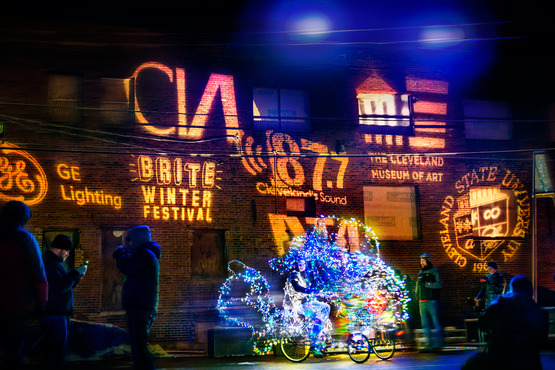
News . Feature Stories . CIA president hails Cleveland's cultural resurgence
News
July 22, 2013
CIA president hails Cleveland's cultural resurgence

By Grafton J. Nunes, President, Cleveland Institute of Art
IT IS EASY for a relative newcomer like me to see that something exciting is happening in Cleveland today. Call it “rust belt chic” or a resurgent Cleveland, this city is reconceiving and rebuilding its sense of self, and re-establishing its reputation as a great place to live and work. To many, it seems like an overnight success. But like all overnight successes, it was a decade in the making and involved the collaborative efforts of many in the public and private sectors.
The devastation caused by economic dislocation, population decline and ecological degradation are all too well-known. But over the last decade there have been individuals and entities who dedicated themselves to rethinking and revitalizing our city. With the critical support and partnership of government—along with numerous foundations, corporations, real estate developers, educational, cultural, and medical institutions—initiatives like Reimagining Cleveland, Rust Belt to Artist Belt, the Cuyahoga County Land Reutilization Corporation, Community Partnership for Arts and Culture, and Cuyahoga Arts and Culture are gaining traction and transforming lives across Greater Cleveland. Residents are hungry for the cultural programming these groups promote.
It has been clear to me that people in this region love to come together to experience music, art, theater, sports and food. This creates great audiences. Great audiences help create a great culture, which in turn enhance the quality of life. These initiatives are social mechanisms that channel and intensify the area’s natural vitality and are a testament to the creative vision, fortitude and enduring faith of Clevelanders who never gave up.
When I lived in New York City and later in Boston, I saw firsthand how artists could play an important role in the social transformation of a place. Obvious examples are Soho in lower Manhattan and the South End in Boston. Once the bustling mercantile trade centers of their cities, manufacturing moved away after World War II, leaving industrial wastelands of crumbling factories and sweatshops. From the ‘60s through the ‘80s, visual and performing artists moved in, drawn by reasonable rents, high ceilings, and an abundance of open space and natural light. The artistic product attracted galleries and theaters which in turn spawned the cafes, restaurants and boutiques. The same dynamic has been repeated in Chelsea and DUMBO in New York, and the Combat Zone and Fort Point in Boston. I believe we are seeing the early stages of a similar phenomenon in Cleveland, except now the neighborhoods are Collinwood, Detroit Shoreway, and Tremont. The challenge will be to maintain the dynamic mix of art and commerce without the gentrification that makes it economically difficult for the social pioneers who revitalized each neighborhood to remain.
It is wonderful to see the Cleveland art scene getting attention outside of Ohio. Michelle Aldredge, founder and writer for the blog ‘Gwarlingo’ said it best after a visit to Cleveland to address CIA students. Now gone viral, her post is titled “The Cleveland art scene, be prepared to be surprised.” She says, “It is artists in cities like Cleveland and Detroit who are in the best position to re-imagine our industrial landscapes and turn them into something new and unique, something we cannot even fathom at present. And such changes won’t occur in a vacuum. There must be community engagement, as well as dialogue and cross-pollination between disciplines, racial groups, and economic classes. This is why programs like the Cleveland Clinic’s Arts and Medicine Institute, the Cleveland Institute of Art’s biomedical art program, and Kent State’s Cleveland Urban Design Collaborative are so essential.”
Looking through the CIA lens, I’m grateful for the opportunities that this new renaissance is bringing to Cleveland. I see this journal, and each of the members of the Collective Arts Network as part of that success. CIA of course has its role to play too. As part of the visual arts and design ecosystem in Cleveland, CIA will continue to bring new creative talent to Northeast Ohio from other parts of the state, country and beyond to inspire and educate the next generation of art and design students in the creative thinking and processes they will need to produce work that will enrich our spirits, our environments and our lives. Eventually many of these CIA students will make Cleveland their home, and contribute to Cleveland’s neighborhoods, galleries, museums, manufacturers, design studios, and economy.
We are all connected. Our successes all reflect on each other in one way or another. As a relative newcomer, I can look at our present with fresh eyes, informed by my experiences in other cities. And I see a dynamic culture that is uniting art and commerce, education and medicine in a yeasty mixture of voltage and movement. All of our ships are rising on the same tide. Mutual appreciation and collaboration will maintain the momentum of renaissance that I am convinced Cleveland is creating. Let’s celebrate together!
Above: Brite Winter Festival
Reprinted with permission from CAN Journal, a publication of the Collective Arts Network | Cleveland, Summer 2013.
Latest Headlines view all
-
April 02, 2024
Cleveland Institute of Art students partner with Progressive Art Collection to exhibit Ready, Set, Relay! -
March 04, 2024
Cleveland Institute of Art announces Curlee Raven Holton Inclusion Scholar Program -
November 06, 2023
Collision of art and artificial intelligence creates murky waters for artists, curators and educators
Questions?
For more information about this or other CIA news, contact us here.
Social Feed